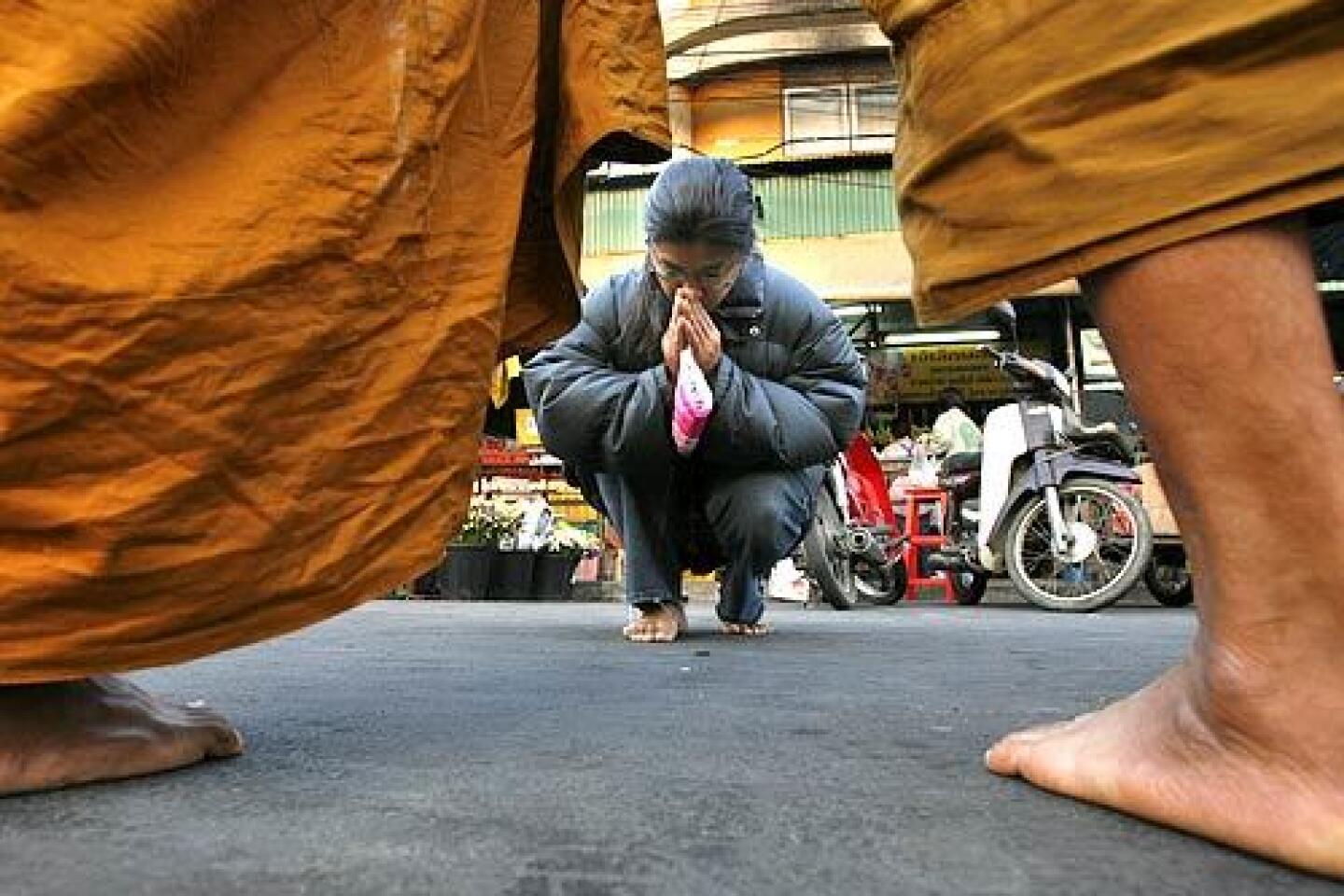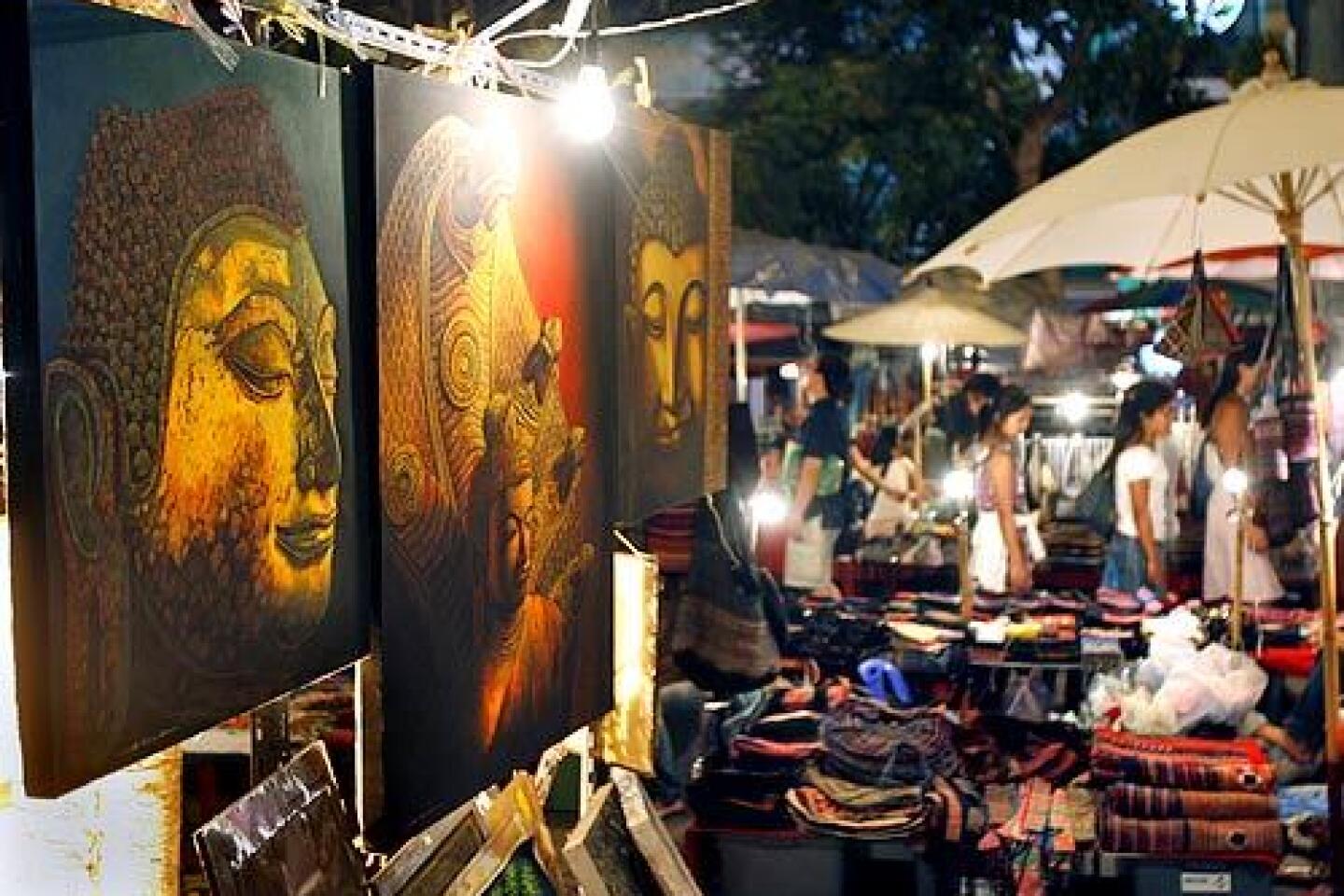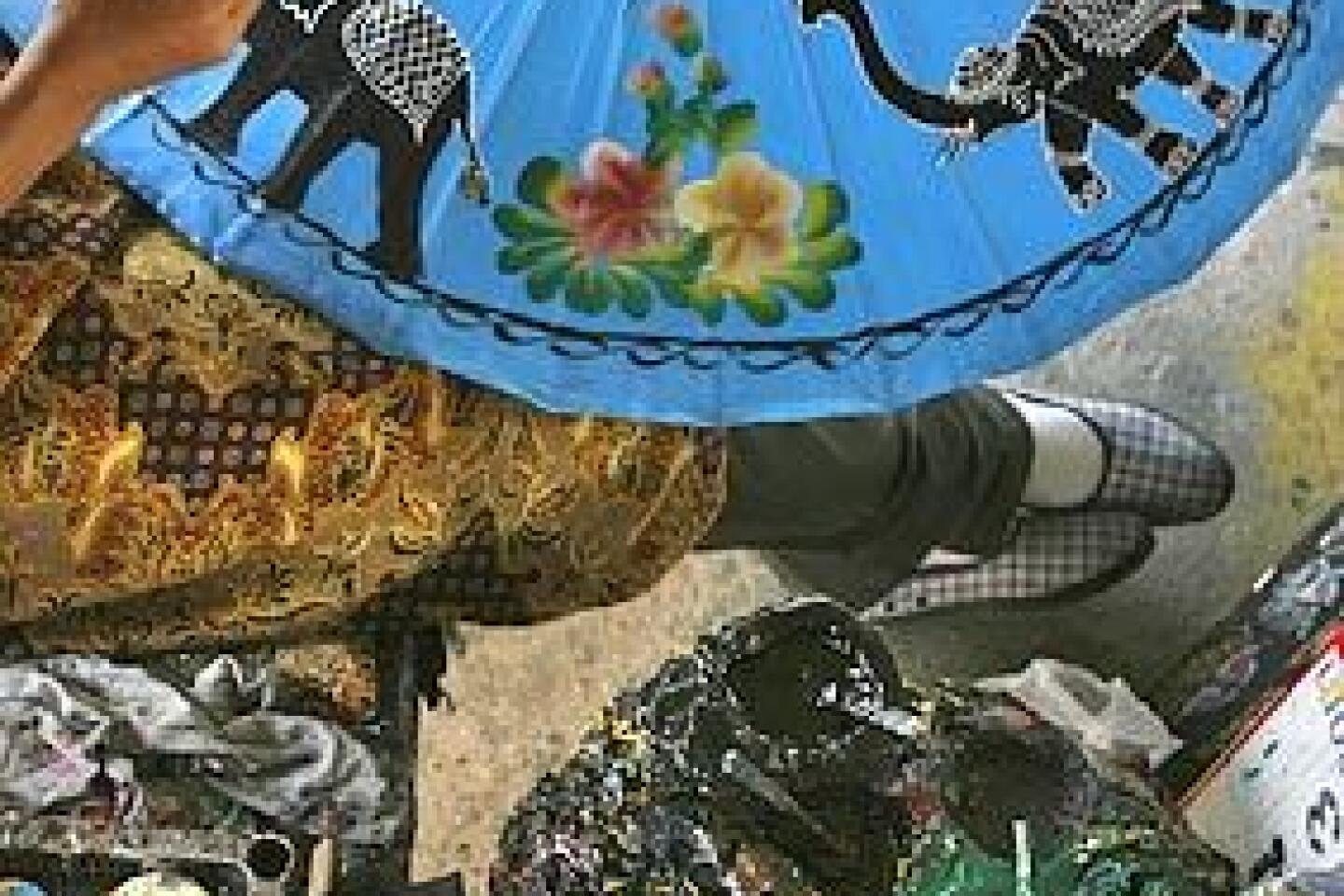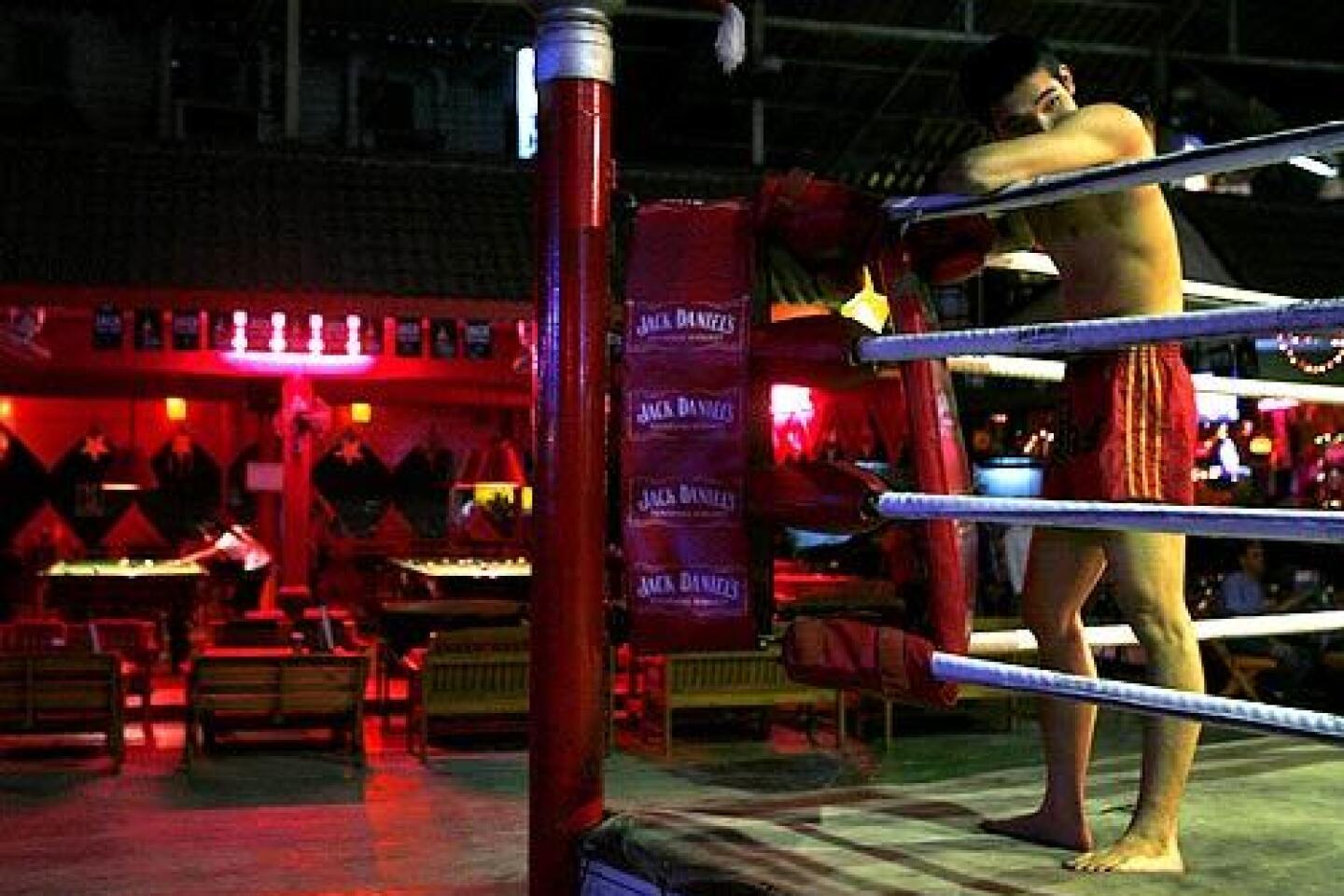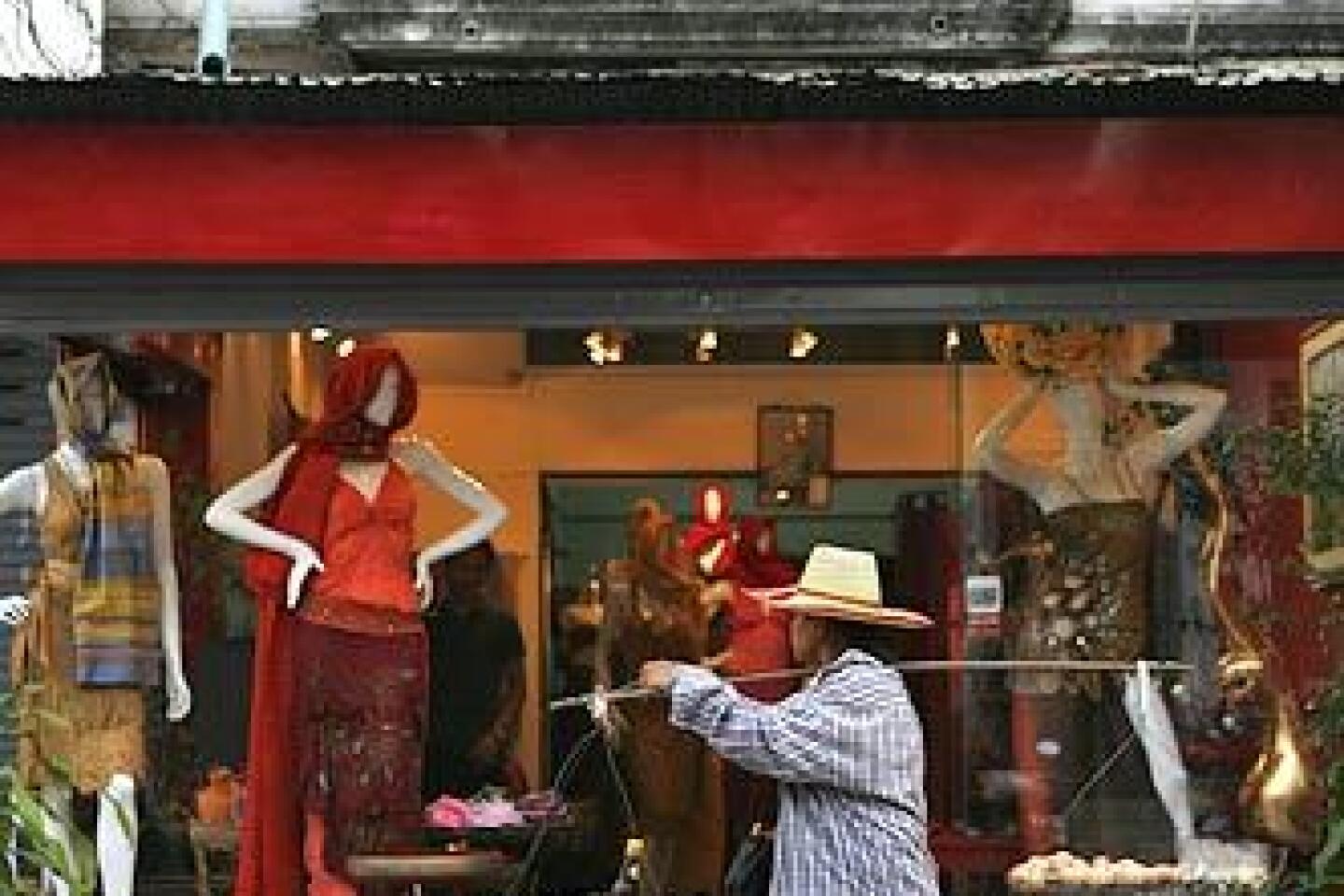Dazzling, dizzying Chiang Mai
- Share via
Chiang Mai, Thailand — ABOUT 30 years ago, the gods of style looked down from design heaven on a town in central New Mexico. It was dusty and small, but they thought it had potential, so they nodded and turned it into Santa Fe.
They worked the same magic in Art Deco South Beach, French-Moroccan Marrakech and Midcentury Modern Palm Springs, transforming unlikely places into global centers for cool contemporary architecture and design.
They’re at it again in Chiang Mai, the old northern capital of Thailand, founded at 4 a.m. on the eighth day of the waxing moon in the month of Visakha and the Year of the Monkey, or 1296, a date dictated by Indian cosmology. More than 700 years later, a construction boom has given Chiang Mai some of the most stylish hotels and restaurants in Southeast Asia. Galleries and design stores have opened, showcasing a trove of textiles, ceramics, furniture, antiques and architectural salvage. Builders have sought inspiration from the gilded temples and traditional teakwood houses. Designers and buyers come for the arts and crafts, which add an elegant Asian echo to contemporary minimalism.
A decade ago, there was nothing cutting-edge about Chiang Mai, 400 miles north of Bangkok. The backpacker crowd chilled out in budget digs, trekked to ethnic tribal villages in the countryside, bought fake objets d’art and feasted on dollar-a-plate pad Thai.
But then Thaksin Shinawatra, the prime minister of Thailand, started to lavish funds on the city of his birth, giving it new superhighways, an airport expansion and growth incentives.
Almost overnight, locals say, things went from quite dull to dynamic.
The implications are obvious for travelers like me who like to shop. But beyond that, I wanted to experience Chiang Mai’s stylistic swirl, to see whether it made visiting the city, eating in its restaurants and staying in its hotels even more attractive.
I came here in November, the cool season — which was, nevertheless, sultry. It was my first trip to Thailand, and I immediately realized how wrong I had been to think of this country as a developing nation. Leaving the Chiang Mai airport, I saw the evidence of Western-style modernization: fast-food restaurants, gas stations, condo complexes and shopping malls. Only when we crossed the moat into the old city did I feel I was leaving the familiar behind.
A contemporary look
TO find the city’s best contemporary design, I relied on the lushly illustrated “Chiang Mai Style” and “Lanna Renaissance” by Joe Cummings, a longtime Chiang Mai resident. His books ultimately led me to the Four Seasons Resort Chiang Mai and the new Mandarin Oriental Dhara Dhevi. Both are the stuff of luxury-hotel fantasies, and they have rates to match.I settled instead into a $50 double at the amiable River View Lodge, which has a small swimming pool, waterfront garden and idiosyncratic collection of Thai tchotchkes, and took the shuttle to the village of Mae Rim, about 20 miles north of town.
It let me out at the Four Seasons entrance, so low-key that it belies the wonders inside.
It’s set in a veritable botanic park, where a small lake is surrounded by rice paddies, streams, waterfalls and flowering plants.
Designer Ajarn Chulathat Kitibutr evoked a traditional hill country village by incorporating the style known as Lanna, and its signatures are everywhere: wood-plank walkways and bridges with slated railings, buildings raised by stilts, L-shaped verandas shaded by deep eaves, high-pitched, shingled roofs and ornamented gables.
Abacus Design of Bangkok filled the resort with Lanna painting, tapestry, ceramics, geometric-shaped paper lanterns, gold stenciling and narrative murals. The guest rooms are in pavilions on stilts. They have spacious verandas and are scattered over the 20-acre grounds. The beds are canopied in gauzy white cotton, and the rooms have upholstered rattan furniture, and teak cupboards and chests. The result is dreamy but understated, in harmony with the Lanna style, born when Chiang Mai was the capital of the La Na Thai, the land of a million rice fields, almost 700 years ago.
I took it all in on a tour with a staff member, at lunch on a terrace above the infinity pool and during a 60-minute aromatic massage at the resort’s award-winning spa, where every artfully carved window panel, lacquered tea tray, exotic flower arrangement and Thai cotton throw is a visual bliss treatment. I chose nutmeg oil for the massage, which started with a foot bath. When I turned on my stomach, I discovered that a pale green bowl with red roses floating in it had been placed below the doughnut-shaped pillow where my face rested, just in case I opened my eyes.
The Mandarin Oriental Dhara Dhevi, which opened in 2004, is in a walled compound on the east side of the city, near the umbrella-making village of Bo Sang and the weaving workshops of San Kamphaeng. The resort was the brainchild of Suchet Suwanmongkol, a successful Thai car dealer. He built himself a house in Chiang Mai, then decided he needed a place where his friends could stay, and Dhara Dhevi was born.
The resort was designed and decorated by a thousand of the region’s most accomplished craftspeople. It reflects styles from all the regions that influenced the great Lanna kingdom, including Laos, China and Burma. The 60-acre compound, with its own spire-studded skyline, is meant to resemble a Lanna city. Indeed, some guests leave thinking that the Dhara Dhevi really is an ancient city.
From the front gate, you can take a golf cart, pedicab or horse-drawn carriage to the open-air lobby. As you go, wooden planks rumble under the wheels of the vehicle; they were built to rattle, evoking old Chiang Mai.
The lobby, under crenelated pagodas, is reached by a magisterial staircase. At the top, you find a long, burnished check-in desk instead of a stupa, surrounded by sveltely decorated alcoves where it’s easy to imagine W. Somerset Maugham or Joseph Conrad nursing a cocktail.
From this perch, you can see the resort’s colonial wing and pool, wrapped around the lobby’s west side. Its rooms bespeak the late 19th and early 20th centuries in Chiang Mai, when the English Burma Co. inveigled a contract from the king of Siam to harvest teak in northern Thailand. Officials of the timber company brought Victorian arches, colonnades, porticoes and louvered shutters to Chiang Mai, which blended surprisingly well with Lanna architecture.
More traditional Lanna design inspired the guest villas, surrounding the resort’s rice paddies, where you may see a farmer using a water buffalo. The architecture of the single-story vegetable villas, built around a cottage garden, echoes that of northern Thai rice barns. There is nothing rustic about the interiors, though, with their opulent blend of Thai silks, hill tribe textiles and custom-designed teak furniture. Some villas have their own serene plunge pools.
The danger in staying at a place like the Dhara Dhevi or the Four Seasons is that you have scant inclination ever to step outside the gate.
Into the city
BUT because I was not staying there, I roamed all over Chiang Mai, mostly on foot but sometimes by tuk-tuk, a sort of motorized rickshaw.The city, sprawling well beyond its medieval moat, has no modern mass-transit system. Sidewalks are narrow and cracked. You need courage to cross a busy street. In the inevitable heat, sightseeing tends to be fatiguing but rarely fails to fascinate.
I temple-hopped and toured the Chiang Mai City Arts and Culture Center in a landmark colonial-era building on the north side of the old town, overlooking Three Kings Monument. One day, I engaged a car and driver to take me up the mountain to Doi Suthep. There, a 300-step staircase leads to a tall, gilded pagoda said to enshrine a revered relic, sometimes identified as Buddha’s alms bowl or his ashes or his left leg bone. The temple compound was jammed with pilgrims and tourists lighting incense sticks and leaving lotus blossoms in front of statues of Lord Buddha and the bodhisattvas.
The visual landscape was as enticing as the culinary one. At every turn, makeshift stalls with hot plates and chopping boards offered an enticing array of Thai street food: skewers of barbecued chicken coated in peanut sauce, steaming bowls of spicy noodle soup, ice cream for 10 cents a scoop.
Generally, in the evening, I dined up-market, though even at Baan Suan, a stunning northern Thai compound, the most expensive dish on the menu was $7. Baan Suan, about 10 miles north of town, specializes in northern Thai cuisine, including frog legs cooked in basil. Noisy croaking on the riverbanks suggested that the meat was quite local.
Darkness fell as I tucked into a plate of soft-shell crab and another of curried chicken in coconut sauce. A man rowed a boat across the river, then lighted a chain of lanterns, visual poetry to go with dinner.
The food and atmosphere were different but equally enchanting at the restaurant in the Chedi Hotel, which is so close to the Ping River that floods delayed its opening in 2005. The hotel has huge, blank exterior walls that hide a showstopping courtyard, with the stunningly restored old British Consulate building as its center of attention. This teak Thai-Victorian blend, built in 1913, now houses the restaurant, which spills onto a candlelit terrace.
The menu features international, Thai and Indian cuisine. I went Indian: pomelo and sweet chili salad, buttered chicken tikka.
That was a $50 meal, but prices in Chiang Mai are widely divergent. At most stylish shops, hotels and restaurants, you pay premium prices; everywhere else, it’s inexpensive by U.S. standards.
For this reason, savvy shoppers take their time. I met an English couple who had come to Chiang Mai to buy antiques, and they were disappointed. Thai antiquities, they said, were rare and expensive, or fakes.
But nothing stops a shopper in Chiang Mai, where cheap treasures are abundant and acquiring them becomes an obsession. I went many times to the Night Market. I found a woven cotton dress with a Chinese collar and frog buttons at the Anusarn Market. At the Warorot Market, by the footbridge over the Ping River, I bought a big bouquet of lotus blossoms for $1 and got an eyeful when I stopped to watch a woman industriously pulling live frogs out of a bag, smashing them on the head with a mallet, then throwing their twitching little carcasses into a tin bowl. That night’s frog legs with basil.
Chiang Mai’s upscale design shops, where I sometimes made purchases but mostly got ideas, are clustered in three places: Nimmanhaemin Road, Tha Phae Road and along Charoenrat Road in the Wat Ket district, on the east side of the Ping River.
With its mud-brown color and trash-lined banks, the river is no garden spot. But it is fun to cross on the footbridge with saffron-robed monks going to and from the 15th century Ketkaram Temple. I could imagine, on a landing near the east end of the bridge, cargo boats with scorpion-tail sterns delivering merchandise from Bangkok and loading up again to take Golden Triangle goods back to the capital. Chinese merchants managed trade in the late 19th and early 20th centuries; they built shop houses along Charoenrat Road, where they did business on the first floor and lived in upper floors. About the same time, European teak wallahs moved into the Wat Ket district, building mansions set back from the street, with plentiful Victorian gingerbread.
Many of Wat Ket’s Chinese shop houses and teak wallah mansions have been restored and showcase goods made in traditional ways but updated by contemporary designers. At Sop Moei Arts and Vila Cini, I found Thai silk table runners and pillow covers, fabric and bamboo wall hangings, tasseled lanterns and beautifully woven water hyacinth chairs.
Farther along Charoenrat Road, I stopped at the TreeHouse, which specializes in doors, windows and shutters salvaged from old Lanna-style houses.
On the way back to central Chiang Mai, I wandered into Ketkaram Temple, a classic Thai Buddhist compound with a school, playground, kitchen, gold-spired stupa and a curious little museum full of vintage black-and-white photos, cracked china and opium spoons.
As I sat down on a bench to cool off, a dozen uniformed schoolboys assembled around a huge bronze gong. When a teacher appeared, they performed a series of prostrations and then began banging on the gong, laughing and chattering until I applauded and they suddenly turned shy.
I took that moment home with me, along with a suitcase full of treasures, including an opium pipe with a slender, tapering handle and a bowl shaped like a flying elephant. At the shop on Tha Phae Road where I got it, the woman said it was definitely antique — possibly 20 or 40 years old.
It doesn’t matter. In Chiang Mai, the old is new, the new old. And, like 1296, this is a very good year.
susan.spano@latimes.com
*(INFOBOX BELOW)
Planning this trip
THE BEST WAY
From LAX, connecting service (change of plane) to Chiang Mai is available on Thai, Singapore, China, Eva and Malaysia airlines. Restricted round-trip fares begin at $850.TELEPHONES
To call the numbers below from the U.S., dial 011 (the international dialing code), 66 (country code for Thailand) and the local number.WHERE TO STAY
Regina Riverside Guesthouse, 69-73 Charoenrat Road, Wat Ket district, Chiang Mai; 53-262-882. Six tiny rooms. Doubles $11, with breakfast.River Ping Palace, 385/2 Charoen Prathet Road, Chiang Mai; 53-274-932, riverpingpalace.tripod.com. Nine guest rooms. Doubles $45, with breakfast.
River View Lodge, 25 Charoen Prathet Road, Chiang Mai; 53-271-109, https://www.riverviewlodgch.com . Doubles $41 to $51, including breakfast.
WHERE TO EAT
Baan Suan, 25 Moo 3, San Phi Sua, 53-854-169. Thai cuisine, $15 to $20 per person, dinner only.Sate, on Inthawarorot Road near the Chiang Mai City Arts & Culture Center, is a peanut barbecue spot; main dishes $2 to $3.
Bo A Cho, an open-air place in the Anusarn Market with seafood delicacies such as prawns in corn sauce and curried crab in the shell; meals about $10.
GALLERY RESTAURANTS
Antique House, Charoen Prathet Road near the Iron Bridge, Chiang Mai, 53-276-810, sells antiques and serves a range of Asian cuisine.The Gallery, 25-29 Charoenrat Road, Wat Ket district, Chiang Mai, 53-248-601, is a craft shop and eatery.
TO LEARN MORE
Tourism Authority of Thailand, or TAT; (323) 461 9814, www.tourismthailand.org.More to Read
Sign up for The Wild
We’ll help you find the best places to hike, bike and run, as well as the perfect silent spots for meditation and yoga.
You may occasionally receive promotional content from the Los Angeles Times.

